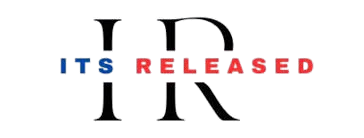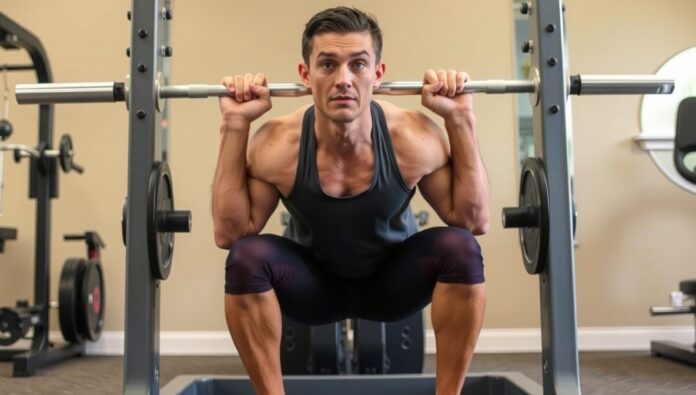Smith Machine Squat is one of the best exercises to build strong legs safely. Many people who want to gain muscle or improve their leg strength choose smith machine squat because it helps control the weight and keeps balance easier than free weights. Using the smith machine squat, you can focus on your muscles without worrying too much about falling or losing control. This exercise works your thighs, glutes, and even your core, making it a full lower-body workout. Beginners and experienced lifters both can benefit from smith machine squat because you can adjust the weight and technique according to your fitness level. Learning the correct form is very important to avoid injuries and get the best results.
When doing smith machine squat, it is important to understand the right position and movement. Place your feet correctly, keep your back straight, and go down slowly while keeping control of the weight. Many people make mistakes like leaning forward too much or letting their knees go past their toes, which can cause pain or injury. By practicing smith machine squat regularly, you can improve your leg strength, balance, and overall fitness. You can also combine it with other exercises like lunges or leg presses to make your workout more complete. With patience and proper technique, smith machine squat can help you build strong, toned legs and boost your confidence in the gym.
How to Do a Proper Smith Machine Squat
To perform smith machine squat correctly, start by adjusting the bar to shoulder height. Stand under the bar with your feet shoulder-width apart. Place the bar across your upper back, not your neck, and grip it firmly. Keep your chest up, back straight, and core tight. Slowly lower your body by bending your knees and hips, going as low as your flexibility allows while keeping your heels on the ground. Pause at the bottom for a second, then push through your heels to return to the starting position. Focus on controlled movements rather than speed.
Proper form is essential to avoid injuries. Many people make mistakes like leaning forward too much or letting the knees go past the toes. These errors can cause knee or lower back pain. Using a mirror can help you check your posture, or you can ask a trainer for guidance. Beginners should start with light weights to master the technique before adding more resistance. Over time, you can increase the weight gradually to build more strength and muscle mass.
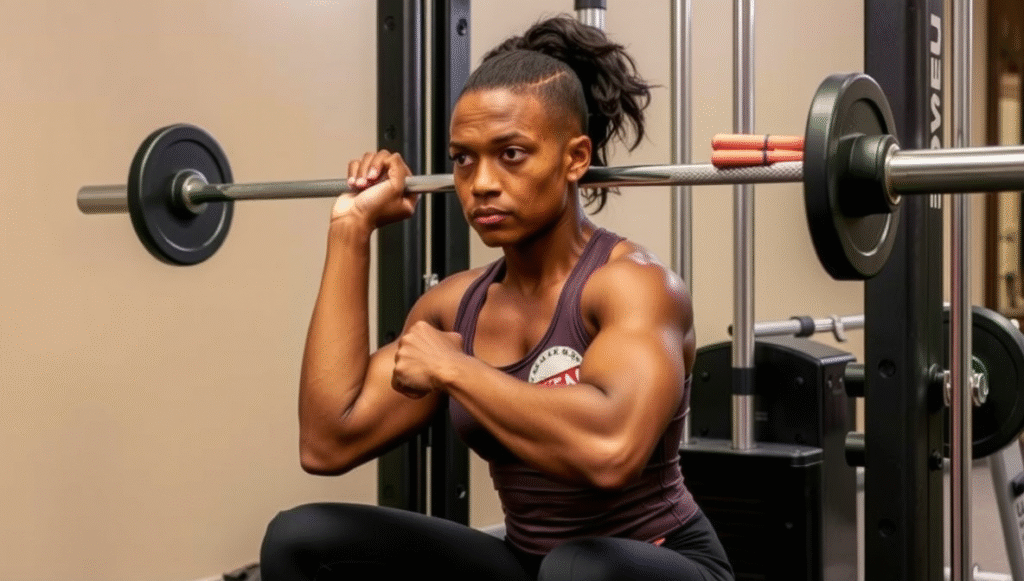
Benefits of Smith Machine Squat
Smith machine squat offers several benefits for both beginners and advanced lifters. First, it improves lower body strength. Strong legs help with everyday activities like walking, climbing stairs, or lifting objects. Second, it enhances muscle tone. Regularly performing smith machine squat can create firm, well-defined thighs and glutes. Third, it is safer than free-weight squats for beginners because the guided bar reduces the risk of losing balance. Fourth, it can improve core stability as your abs and lower back engage to maintain proper posture.
Another benefit of smith machine squat is versatility. You can change foot position to target different muscles. For example, placing feet closer together focuses more on the quadriceps, while a wider stance targets the glutes and inner thighs. Smith machine squat also helps prevent plateauing in workouts. By adjusting weight, reps, or stance, you can continually challenge your muscles and make progress. Additionally, it can be a great addition to home gyms because it provides a safe way to lift heavy without a spotter.
Smith Machine Squat vs Free Weight Squat
Many people wonder whether smith machine squat is better than free weight squat. Both exercises have advantages, but the choice depends on your goals and experience. Free weight squats engage more stabilizer muscles and improve balance, but they require proper technique to avoid injuries. Smith machine squat, on the other hand, provides a controlled environment, making it safer for beginners and those focusing on muscle isolation. It allows lifting heavier weights without worrying about balance, which can lead to faster muscle growth in the legs.
For beginners, smith machine squat is often recommended to build confidence and master the basic squat movement. Advanced lifters can combine both exercises in their routine to get the best of both worlds: stability from smith machine squat and functional strength from free weights. Regardless of choice, maintaining proper form and progressively increasing resistance is crucial for long-term results.
Common Mistakes in Smith Machine Squat
Even with the guided bar, mistakes can happen. One common error is leaning too far forward, which puts pressure on the lower back. Another mistake is letting the knees go past the toes, which increases the risk of knee injury. Some people do not lower their body enough, limiting the effectiveness of the exercise. Others may lift too fast, reducing muscle engagement and increasing the chance of strain.
To fix these mistakes, focus on controlled movements. Keep your chest up, back straight, and core engaged. Use a full range of motion, going as low as comfortable while keeping your heels on the floor. Practice with lighter weights until the form feels natural. Watching yourself in a mirror or recording your squats can help identify and correct mistakes. Small adjustments in posture and movement can make a big difference in safety and results.
Variations of Smith Machine Squat
Smith machine squat is highly versatile, and variations can target different muscles. Front stance smith machine squat shifts focus to the quadriceps and upper legs. Wide stance or sumo smith machine squat emphasizes glutes and inner thighs. Narrow stance works more on the outer thighs. Another variation is the single-leg smith machine squat, which challenges balance and strengthens each leg individually. These variations can prevent boredom and ensure a well-rounded lower body workout.
For those seeking advanced training, adding pauses at the bottom of the squat increases time under tension, leading to more muscle growth. Combining smith machine squat with other exercises like lunges, leg presses, or Romanian deadlifts can create a complete leg workout. Mixing variations keeps your muscles challenged and promotes steady progress.
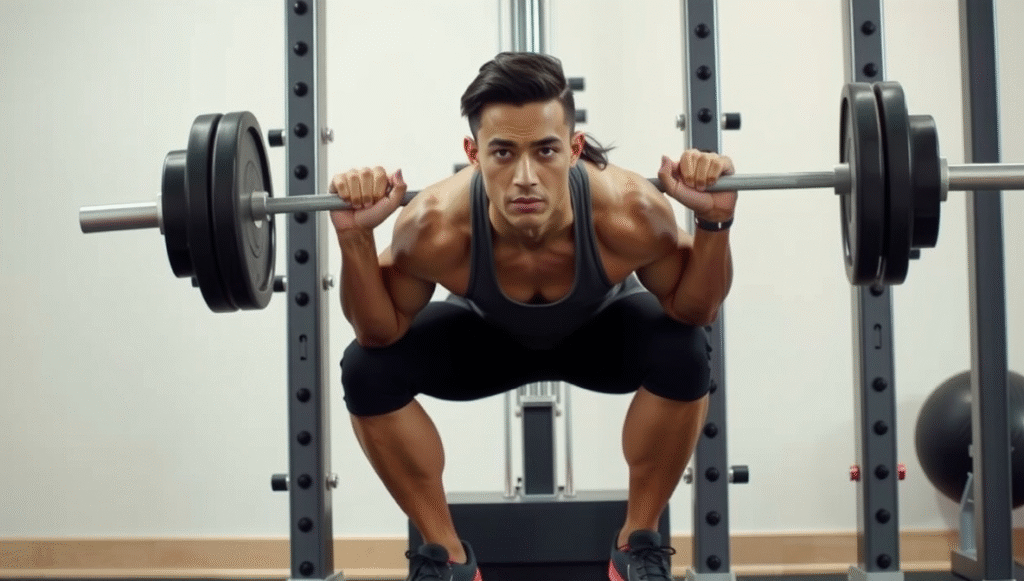
How Often to Do Smith Machine Squat
Frequency depends on your fitness level and goals. Beginners can start with two to three sessions per week, allowing a day of rest between workouts. This gives muscles time to recover and grow. Intermediate and advanced lifters can perform smith machine squat three to four times per week, adjusting volume and intensity as needed. Overtraining can lead to fatigue or injury, so listen to your body and allow adequate recovery.
Combining smith machine squat with other leg exercises ensures balanced development. For example, pairing squats with lunges, calf raises, or leg curls can strengthen all major lower body muscles. Proper nutrition and rest are equally important to support muscle recovery and growth.
Safety Tips for Smith Machine Squat
Smith machine squat is safer than free-weight squats, but safety precautions are still important. Always adjust the bar height properly before starting. Use safety stops if available to prevent the bar from falling too low. Wear proper footwear with a flat, firm sole for stability. Keep your core tight and back straight throughout the movement. Avoid sudden jerky motions and focus on smooth, controlled reps.
It is also helpful to warm up before performing smith machine squat. Light cardio and dynamic stretches prepare your muscles and joints for exercise. After your workout, stretch again to reduce soreness and improve flexibility. Using these safety tips reduces the risk of injury and makes the exercise more effective.
Benefits for Beginners
Beginners often feel intimidated by free-weight squats, but smith machine squat is beginner-friendly. It allows controlled movement, which helps build confidence. Learning proper squat form on a smith machine makes transitioning to free-weight squats easier later. Beginners can start with lighter weights and gradually increase resistance without a spotter. Smith machine squat also provides consistent results as it targets muscles evenly.
For beginners, combining smith machine squat with other basic leg exercises like bodyweight squats, step-ups, or glute bridges creates a strong foundation. Over time, as strength and balance improve, they can explore more advanced variations to keep progressing.
Smith Machine Squat for Advanced Lifters
Advanced lifters can still benefit from smith machine squat. Using heavier weights and incorporating variations challenges muscles in new ways. Adding pauses, performing slow eccentrics (lowering phase), or using narrow and wide stances increases intensity. Advanced lifters can also combine smith machine squat with other leg exercises in supersets or circuits for maximum growth and endurance.
Even for advanced lifters, maintaining proper form is crucial. Overloading without correct technique can lead to injuries. The smith machine provides a controlled environment to safely push limits while focusing on muscle isolation and strength development.
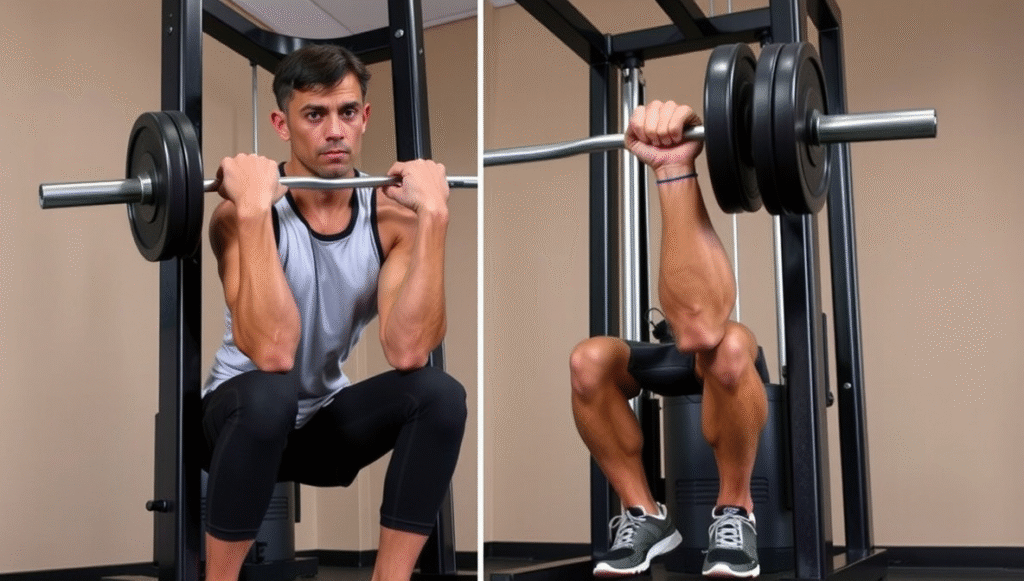
Conclusion
Smith machine squat is an excellent exercise for building strong legs, glutes, and core muscles. It is safe, beginner-friendly, and versatile, allowing you to target different muscles through variations. Proper form, controlled movements, and regular practice are key to maximizing benefits. Beginners can start with light weights, while advanced lifters can use heavier loads and variations to challenge muscles. Combining smith machine squat with other leg exercises ensures balanced development and faster progress. By following safety tips, warming up properly, and maintaining consistency, smith machine squat can become a cornerstone of your leg training routine, helping you achieve stronger, toned, and healthier legs.
FAQs
What muscles does smith machine squat work?
It mainly targets quadriceps, hamstrings, glutes, and calves, while also engaging the core.
Can I do smith machine squat at home?
Yes, if you have access to a smith machine or similar equipment, it is safe and effective for home workouts.
Should I use heavy weights or light weights?
Start with lighter weights to master form, then gradually increase for strength and muscle growth.
